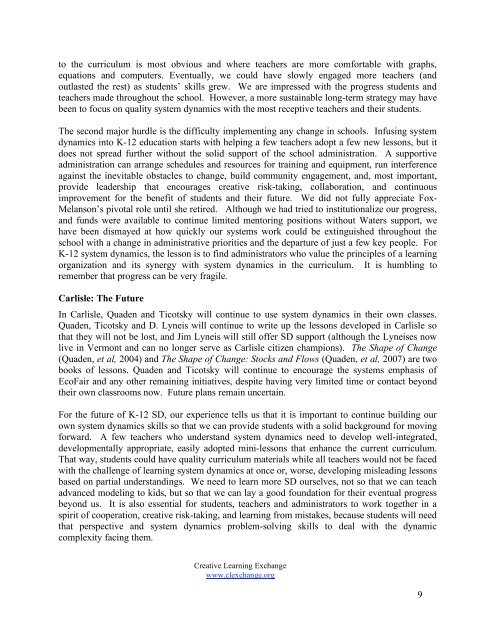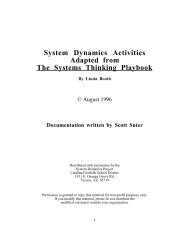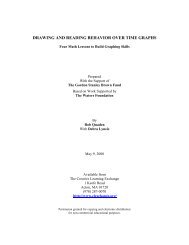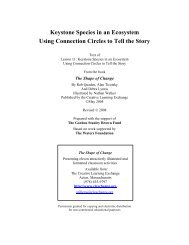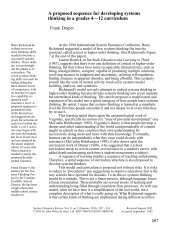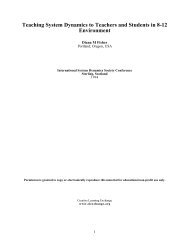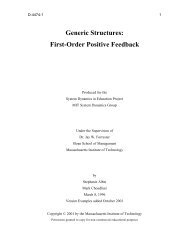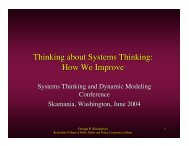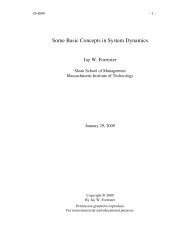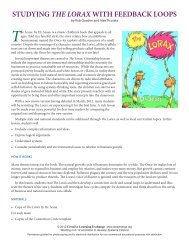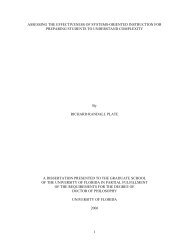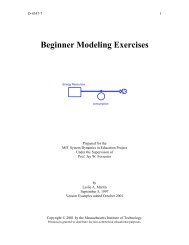System Dynamics in K-12 Education: Lessons Learned - Creative ...
System Dynamics in K-12 Education: Lessons Learned - Creative ...
System Dynamics in K-12 Education: Lessons Learned - Creative ...
Create successful ePaper yourself
Turn your PDF publications into a flip-book with our unique Google optimized e-Paper software.
to the curriculum is most obvious and where teachers are more comfortable with graphs,<br />
equations and computers. Eventually, we could have slowly engaged more teachers (and<br />
outlasted the rest) as students’ skills grew. We are impressed with the progress students and<br />
teachers made throughout the school. However, a more susta<strong>in</strong>able long-term strategy may have<br />
been to focus on quality system dynamics with the most receptive teachers and their students.<br />
The second major hurdle is the difficulty implement<strong>in</strong>g any change <strong>in</strong> schools. Infus<strong>in</strong>g system<br />
dynamics <strong>in</strong>to K-<strong>12</strong> education starts with help<strong>in</strong>g a few teachers adopt a few new lessons, but it<br />
does not spread further without the solid support of the school adm<strong>in</strong>istration. A supportive<br />
adm<strong>in</strong>istration can arrange schedules and resources for tra<strong>in</strong><strong>in</strong>g and equipment, run <strong>in</strong>terference<br />
aga<strong>in</strong>st the <strong>in</strong>evitable obstacles to change, build community engagement, and, most important,<br />
provide leadership that encourages creative risk-tak<strong>in</strong>g, collaboration, and cont<strong>in</strong>uous<br />
improvement for the benefit of students and their future. We did not fully appreciate Fox-<br />
Melanson’s pivotal role until she retired. Although we had tried to <strong>in</strong>stitutionalize our progress,<br />
and funds were available to cont<strong>in</strong>ue limited mentor<strong>in</strong>g positions without Waters support, we<br />
have been dismayed at how quickly our systems work could be ext<strong>in</strong>guished throughout the<br />
school with a change <strong>in</strong> adm<strong>in</strong>istrative priorities and the departure of just a few key people. For<br />
K-<strong>12</strong> system dynamics, the lesson is to f<strong>in</strong>d adm<strong>in</strong>istrators who value the pr<strong>in</strong>ciples of a learn<strong>in</strong>g<br />
organization and its synergy with system dynamics <strong>in</strong> the curriculum. It is humbl<strong>in</strong>g to<br />
remember that progress can be very fragile.<br />
Carlisle: The Future<br />
In Carlisle, Quaden and Ticotsky will cont<strong>in</strong>ue to use system dynamics <strong>in</strong> their own classes.<br />
Quaden, Ticotsky and D. Lyneis will cont<strong>in</strong>ue to write up the lessons developed <strong>in</strong> Carlisle so<br />
that they will not be lost, and Jim Lyneis will still offer SD support (although the Lyneises now<br />
live <strong>in</strong> Vermont and can no longer serve as Carlisle citizen champions). The Shape of Change<br />
(Quaden, et al, 2004) and The Shape of Change: Stocks and Flows (Quaden, et al, 2007) are two<br />
books of lessons. Quaden and Ticotsky will cont<strong>in</strong>ue to encourage the systems emphasis of<br />
EcoFair and any other rema<strong>in</strong><strong>in</strong>g <strong>in</strong>itiatives, despite hav<strong>in</strong>g very limited time or contact beyond<br />
their own classrooms now. Future plans rema<strong>in</strong> uncerta<strong>in</strong>.<br />
For the future of K-<strong>12</strong> SD, our experience tells us that it is important to cont<strong>in</strong>ue build<strong>in</strong>g our<br />
own system dynamics skills so that we can provide students with a solid background for mov<strong>in</strong>g<br />
forward. A few teachers who understand system dynamics need to develop well-<strong>in</strong>tegrated,<br />
developmentally appropriate, easily adopted m<strong>in</strong>i-lessons that enhance the current curriculum.<br />
That way, students could have quality curriculum materials while all teachers would not be faced<br />
with the challenge of learn<strong>in</strong>g system dynamics at once or, worse, develop<strong>in</strong>g mislead<strong>in</strong>g lessons<br />
based on partial understand<strong>in</strong>gs. We need to learn more SD ourselves, not so that we can teach<br />
advanced model<strong>in</strong>g to kids, but so that we can lay a good foundation for their eventual progress<br />
beyond us. It is also essential for students, teachers and adm<strong>in</strong>istrators to work together <strong>in</strong> a<br />
spirit of cooperation, creative risk-tak<strong>in</strong>g, and learn<strong>in</strong>g from mistakes, because students will need<br />
that perspective and system dynamics problem-solv<strong>in</strong>g skills to deal with the dynamic<br />
complexity fac<strong>in</strong>g them.<br />
<strong>Creative</strong> Learn<strong>in</strong>g Exchange<br />
www.clexchange.org<br />
9


